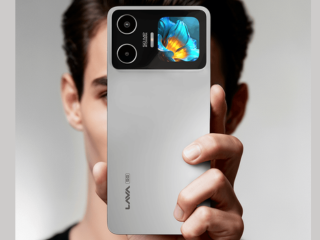- Home
- Mobiles
- Mobiles Reviews
- Oppo K1 Review
Oppo K1 Review

The Oppo K1's highlight feature is the in-display fingerprint sensor. It's on sale for Rs. 16,990
In 2019, we'll see a new wave of flagship smartphones with even thinner display bezels, better cameras and some, without any ports or buttons. Among all this futuristic tech, we can also expect last year's flagship features and technology to trickle down to more mainstream phones.
One of the first instances of this new trend can be seen in the Oppo K1. This is the debut offering in a brand-new series from Oppo, which offers an in-display fingerprint sensor at a very affordable price. In fact, the Oppo K1 is currently the least expensive smartphone in the Indian market with an in-display fingerprint sensor, giving it bragging rights in a market where it's rather difficult to stand out from the competition.
But is that all Oppo has concentrated on, or is the K1 a good all-rounder too? Let's find out in our Oppo K1 review.
Oppo K1 design and build
The Oppo K1 launched around October in China, so it's not exactly brand new, and that shows in the aesthetics and design. There's a strong resemblance to many existing Oppo smartphones such as the Oppo A7 (Review) and the Oppo F9 Pro (Review). The plastic body is well put-together and the phone has a good heft to it, which we liked.
The back of the Oppo K1 has a gradient design, which was very striking in the Astral Blue colour scheme of the unit we have for review. It's also available in a Piano Black trim. The 3D injection-moulded back creates some cool effects when held against light, and it also didn't pick up any visible scuffs during our review period. However, it does pick up fingerprints quite easily.
The placement of buttons is good and so is their build quality. The tray on the left can accommodate two Nano-SIM cards and a microSD card (up to 256GB). Dual 4G VoLTE is also supported. At the bottom we have a speaker grille, a Micro-USB port, and a 3.5mm headphone socket.
![]() The Oppo K1 has a gradient back panel, which looks very striking in this Astral Blue trim
The Oppo K1 has a gradient back panel, which looks very striking in this Astral Blue trim
The Oppo K1 features a 6.41-inch, full-HD+ display with Corning Gorilla Glass 5 for protection, which is always welcome. Since this phone has its fingerprint sensor under the display, Oppo has had to use an AMOLED panel, making it one of the few phones in this segment with this kind of screen. Punchy colours and deep blacks come with the territory of such a display but you can tweak the colour temperature from the Settings app if required.
The Oppo K1 has a water-drop notch at the top, so there's plenty of screen real-estate available for use. The bezel around the display is visible but it's not very thick and neither is the chin at the bottom. Due to the limited space around the selfie camera, there's no notification LED. As always, there's a screen guard pre-applied on the phone.
Around the back, we have the dual-camera module, placed in a similar fashion to what we've see on other Oppo phones such as the F9 Pro. In the box, you'll find a silicone case, SIM eject tool, Micro-USB cable, a 10W power adapter, and headset.
![]() The Oppo K1 is currently the most affordable phone with an in-display fingerprint sensor
The Oppo K1 is currently the most affordable phone with an in-display fingerprint sensor
Oppo K1 specifications and features
In its quest to make this the most affordable phone with an in-display fingerprint sensor, it's nice to see that Oppo hasn't compromised on the main specifications too much. This phone is powered by the reliable Qualcomm Snapdragon 660 octa-core SoC, which we've seen in phones such as the Realme 2 Pro (Review) and Xiaomi Mi A2 (Review).
In India, the Oppo K1 launched in just one variant which has 4GB of RAM and 64GB of storage. You also get dual-band Wi-Fi 802.11ac, Bluetooth 5, USB OTG, GPS, and sensors such as a compass, accelerometer, ambient light sensor, and gyroscope. There's no FM radio.
The Oppo K1 is still rocking ColorOS 5.2 based on Android 8.1 Oreo. We guess we'll have wait a bit longer for the ColorOS 6 debut with some new Oppo smartphones, possibly at MWC 2019. We've explored all the features of this version of ColorOS in our reviews of the Realme U1 (Review) and Realme 2 Pro, so we'll just run through some of the notable ones here.
Game Space has an upgraded look, and Oppo's Hyper Boost game optimisation feature supports PUBG Mobile in addition to other games such as Arena of Valor, Cross Fire, etc. It's said to deliver a “boost” in loading times and game performance. We tried it out with PUBG but it's really hard to tell if there's a tangible benefit to be had, as network performance is always a big variable.
You also get additional features such as Smart Sidebar, which is a pop-out tray for app shortcuts; Smart Scan, which lets you do some multi-lingual translations; and ORoaming, which creates a virtual SIM card with affordable data packs when you're overseas.
Other than the system apps, there aren't a lot of pre-installed third-party apps other than Facebook. The default browser and Oppo's app store continue to clutter your notifications shade with alerts and ads. You can disable the app store's spam but the browser continues to spam you even after disabling this feature. This is the same issue we faced with the Oppo A7 too.
![]() The Oppo K1 uses ColorOS 5.2 which is still based on Android 8.1 Oreo
The Oppo K1 uses ColorOS 5.2 which is still based on Android 8.1 Oreo
Oppo K1 performance, cameras, and battery life
We used the Oppo K1 as our primary device for a couple of days and we didn't have any major complaints when it comes to general usage. The phone does feel a bit large when you hold it so one-handed operation isn't very easy. Despite the glossy texture on the back and sides, it's surprisingly not too slippery.
The AMOLED display produces bright, saturated colours and sunlight legibility is also very good. The display has good touch response too, which was evident when typing. ColorOS also runs smoothy with no hiccups thanks to the 4GB of RAM.
The in-display fingerprint sensor works just the same as what we've used on other phones with this feature, and by that we mean it's not as fast as a standard capacitive sensor. You'll need to keep your finger properly aligned with the fingerprint icon for a full second before the Oppo K1 successfully authenticates you. You can choose between three different fingerprint animations for the lock screen.
We found face recognition to be a lot quicker and more convenient most of the time. Just like with previous Realme and Oppo devices, it's very quick, and works in low light by bumping up the screen brightness to illuminate your face.
![]() The Oppo K1 has a single speaker, a Micro-USB port and a 3.5mm headphone socket at the bottom
The Oppo K1 has a single speaker, a Micro-USB port and a 3.5mm headphone socket at the bottom
The large 6.41-inch display is great for watching videos on. Colours really pop and the black levels are satisfyingly deep. The speaker is fairly loud when watching YouTube videos but for some apps, like PUBG Mobile, it sounds a bit weak even at full volume. The audio quality is average at best, sounding a bit tinny and one-sided, since there's only one speaker at the bottom.
The Oppo K1 had no trouble handling heavy games either. Asphalt 9: Legends was perfectly smooth with the graphics cranked up to the ‘High' preset, while PUBG Mobile delivered a consistently playable framerate at the ‘Medium' graphics setting. We were happy to note that the phone doesn't get too hot when gaming even for more than 30 minutes at a stretch. You also have the option to mask the notch for individual apps if you find it interfering with your content.
Benchmark numbers also indicate that the phone should be able to handle games and general apps pretty well. In AnTuTu, we got a score of 1,28,852 points, while the T-Rex graphics test in the GFXbench benchmark suite returned 41fps.
Coming to the cameras, Oppo has used a standard 16-megapixel camera and a depth sensor on the rear, and a bigger, 25-megapixel sensor with an f/2 aperture on the front, much like it usually uses in its selfie-centric F series.
We start with the selfie camera, which has an artificial intelligence (AI) beautification system. You can manually choose the level of beautification too. Enabling this seemed to smoothen the texture of our skin a bit too much, to a point where it became obvious that some sort of filter was being used.
If you're into this kind of selfies, then you'll like the AI beautification, and if not you can simply turn it off. Image quality without beautification is good in daylight, as textures like skin look a lot more natural. You can have a background blur for selfies, but we found that edge detection wasn't very accurate.
![]() Selfies look more natural without the beautification filter
Selfies look more natural without the beautification filter
![]() AI beauty mode is generally aggressive with skin smoothening (Tap for full-sized images of Oppo K1 cameras samples)
AI beauty mode is generally aggressive with skin smoothening (Tap for full-sized images of Oppo K1 cameras samples)
Selfies taken in low light also hold up well but the Bokeh mode's edge detection issues are more exaggerated here. You get ‘Auto HDR' for the front camera, which helps correct the exposure a bit when shooting against bright light.
The rear 16-megapixel sensor has an f/1.7 aperture, which technically means it should be able to capture good photos in dark environments as it allows more light into the sensor. The Oppo K1 does manage this but only to an extent. In our tests, we saw that noise was handled well in shadows and darker regions in general, but textures weren't very detailed and distant objects in landscapes lacked good definition. Macros in low-light fared a bit better.
Under good light, the main camera captured good details in close-ups. Edges were well defined and colours weren't exaggerated. Landscapes also packed in a fair bit of detail, and HDR seemed to do a decent job of balancing the exposure.
There's a 2x zoom button in the viewfinder but it's just digital and not optical. Shutter lag isn't an issue but we noticed that you can't use the shutter button several times in rapid succession to take multiple pictures as there's a wait of about a second or two before the camera processes your photo and is ready to go again. It's a little annoying as we're used to being able to quickly take multiple photos with most smartphones.
![]()
![]()
![]()
![]() Tap to see full-sized Oppo K1 camera samples
Tap to see full-sized Oppo K1 camera samples
The second 2-megapixel sensor is only used for edge detection when shooting in Portrait mode. It does a decent job with objects and people, with a few minor misses at times. However, the camera takes a while to focus in this mode, even when shooting in good light. The camera app also gives you the standard shooting modes such as Panorama, AR stickers, and an Expert mode, which lets you manually adjust the ISO, focus, and shutter speed.
For video, the Oppo K1 can shoot at up to 4K resolution. Continuous autofocus worked very well in our tests. At 4K, the white balance was generally a bit off. Daylight footage looked too warm and colours were oversaturated. There's also no stabilisation at this resolution, which is a little disappointing. At 1080p though, image quality is better with more accurate white balance, and footage is stabilised.
The Oppo K1 features a 3,600mAh battery, which lasted for a decent 12 hours and 36 minutes in our HD video loop test. This translated to well over a day's worth of actual usage for us, which typically included music streaming, a few calls, Internet browsing, and some gaming. The phone doesn't support Oppo's VOOC fast charging but you do get a 10W power adapter, which takes about two and half hours to fully charge the smartphone.
Verdict
Keeping in mind that the Oppo K1 is the only phone with an in-display fingerprint sensor in its price band, the launch price of Rs. 16,990 is not too bad. We hope it will drop eventually and fall in line with other Snapdragon 660 powered smartphones with comparable RAM and storage configurations, such as the Realme 2 Pro (Review) or the Vivo V9 Pro (Review).
We would have liked some things about the Oppo K1 to have been better. It could have had USB Type-C port and perhaps fast charging as well as better build quality. Low-light camera performance could have been better, and we really wish Oppo would fix that annoying spam from some of its apps in ColorOS.
On the bright side, you get solid app and gaming performance, a punchy and sharp display, decent selfie camera, good battery life, and of course, the novelty of an in-display fingerprint sensor — all of which make the Oppo K1 a good package that's worth considering.
Catch the latest from the Consumer Electronics Show on Gadgets 360, at our CES 2026 hub.
Related Stories
- Samsung Galaxy Unpacked 2025
- ChatGPT
- Redmi Note 14 Pro+
- iPhone 16
- Apple Vision Pro
- Oneplus 12
- OnePlus Nord CE 3 Lite 5G
- iPhone 13
- Xiaomi 14 Pro
- Oppo Find N3
- Tecno Spark Go (2023)
- Realme V30
- Best Phones Under 25000
- Samsung Galaxy S24 Series
- Cryptocurrency
- iQoo 12
- Samsung Galaxy S24 Ultra
- Giottus
- Samsung Galaxy Z Flip 5
- Apple 'Scary Fast'
- Housefull 5
- GoPro Hero 12 Black Review
- Invincible Season 2
- JioGlass
- HD Ready TV
- Laptop Under 50000
- Smartwatch Under 10000
- Latest Mobile Phones
- Compare Phones
- Lava Blaze Duo 3
- Tecno Spark Go 3
- iQOO Z11 Turbo
- OPPO A6c
- Samsung Galaxy A07 5G
- Vivo Y500i
- OnePlus Turbo 6V
- OnePlus Turbo 6
- Lenovo Yoga Slim 7x (2025)
- Lenovo Yoga Slim 7a
- Lenovo Idea Tab Plus
- Realme Pad 3
- Garmin Quatix 8 Pro
- NoiseFit Pro 6R
- Haier H5E Series
- Acerpure Nitro Z Series 100-inch QLED TV
- Asus ROG Ally
- Nintendo Switch Lite
- Haier 1.6 Ton 5 Star Inverter Split AC (HSU19G-MZAID5BN-INV)
- Haier 1.6 Ton 5 Star Inverter Split AC (HSU19G-MZAIM5BN-INV)

















